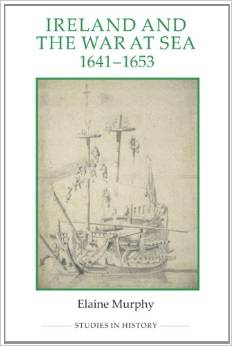Ireland and the War at Sea 1641-1653
Elaine Murphy
 Elaine Murphy’s book examines maritime conflicts that occurred in the waters surrounding Ireland from 1641 to 1653. Throughout much of the seventeenth century, privateering and piracy off of the Irish coast were obstacles for the English navy.
Elaine Murphy’s book examines maritime conflicts that occurred in the waters surrounding Ireland from 1641 to 1653. Throughout much of the seventeenth century, privateering and piracy off of the Irish coast were obstacles for the English navy.
Ireland’s maritime activities changed significantly in the 1640s and 1650s because naval activities and privateering operations in the area escalated and became more complicated with the eruption of rebellion in Ireland and then England’s civil war.
England subsequently not only faced somewhat isolated cases of piracy, but also an expanding and organized privateering organization operating out of some of Ireland’s main port towns.
Murphy’s book is aesthetically well produced, and it has a convenient and generally easy-to-follow layout that is divided into two main parts and a series of appendices. The first part includes four chapters that progress chronologically from the beginning of the rebellion; they provide a history of the wars. She discusses the manner in which the rebellion changed naval concerns as the events at sea gained importance. Murphy then addresses the resilience of the parliamentary navy and the maritime benefits that the Cessation of 1643 provided the royalists and confederates in Ireland.
Irish privateers managed to economically destabilize the parliamentary navy as they gained prizes between 1646 and 1649, but they did not succeed in threatening parliament’s financial foundation. She also claims that the navy proved to be invaluable to Oliver Cromwell in his conquest of Ireland as it facilitated parliamentary armies in combating the royalist coalition. Details such as these emphasize the importance of sea power in warfare and provide an interesting historic perspective.
Within the three chapters of the second part of the book, Murphy analyzes aspects concerning both the parliamentary and confederate naval efforts. She discusses the various ships that were utilized during the time and the significance of maritime activity and prize taking to those involved. The author also examines the war off of the coast of Ireland using archival sources to investigate the conduct of the opposing forces. For example, she notes that the captain of a confederate privateer, Joseph Content, claimed to have taken around thirty-six ships, but there is no clear account of the method he used to succeed. Her use of archival material to address questions such as these in the absence of readily available narratives is extremely intriguing, and she provides information that otherwise could have been lost to antiquity.
The book has a few weaknesses despite its many strengths. Although not essential to the primary objective of the work, it would have been interesting if Murphy had provided additional details concerning the manner in which warfare involving privateers and armed merchantmen fit into a more extensive economic context of Europe around that time. Also, even though the author displays three maps in the beginning of the book, she does not integrate them into the relevant chapters or clearly illustrate the locations of naval conflicts. Nevertheless, several figures, maps, and tables included serve to visually convey information. Murphy also provides six helpful appendices that contain various details, and she incorporates her works cited in the form of endnotes along with a bibliography. The included general index, glossary, abbreviations page, and index of ships are all very useful.
Although Murphy is of the opinion that military campaigns on land often receive more attention than those at sea, she successfully utilizes her work to emphasize the importance of maritime operations around Ireland during the mid-seventeenth century. This book would be particularly useful to those interested in the politics, economics, and logistics of maritime conflict in mid-seventeenth century Ireland. Murphy’s scholarly contribution, though, can be appreciated by anyone with an interest in maritime history.
- Woodbridge, Suffolk: The Boydell Press
- 2012 6-1/2” x 9-1/2”, hardcover, xii + 253 pages
- Maps, glossary, tables, notes, appendices, bibliography, index. $90.00
Reviewed by Alyssa Reisner, East Carolina University
